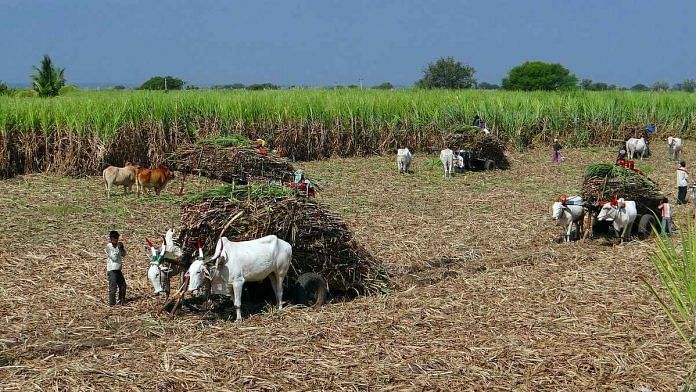New Delhi: Sunday’s Kisan Mahapanchayat in Muzaffarnagar has brought the sugarcane crisis in western Uttar Pradesh to the fore. It was pretty clear that the distress of cane farmers will play a crucial role in the upcoming assembly elections, in the state that produces the most sugarcane in India.
The agrarian crisis in UP’s sugarcane belt has been aggravated in the last few years as farmers have witnessed a slump in income, along with rising input costs. The crisis revolves around three major issues — unchanged prices, delayed or staggered payments, and exponential growth in input costs.
These factors have created deep-seated unrest in UP, which has more than 35 lakh farming families dependent on cane cultivation, out of 60 lakh nationally.
Also read: At Muzaffarnagar mahapanchayat, farmers vow to intensify protest against farm laws
Unchanged prices and erratic payments
Sugarcane cultivation was traditionally quite popular in western Uttar Pradesh, with the state government raising the State Advisory Price (SAP) every year to ensure that it remained profitable for farmers, given the increasing inflation and input costs. However, the cane SAP has remained unchanged for almost three years now, since 2017-18.
The common variety of sugarcane fetches an SAP of Rs 315 per quintal, while the early variety fetches Rs 325 per quintal, and rejected varieties get Rs 310 per quintal. Compare that to Punjab, which goes to the polls alongside UP early next year — it increased the SAP for early varieties to Rs 360 per quintal this year, after keeping it at Rs 310 since 2017-18.
On top of this, farmers’ distress has been aggravated by the delays in payments. The Sugarcane (Control) Order, 1966, mandates payment to farmers within 14 days from the date of supply of sugarcane, failing which an interest of 15 per cent per annum is applicable on the due amount.
However, sugar mills allege that liquidation of stock is spread throughout year, and often goes beyond the 14 days’ deadline, mounting huge arrears on them with heavy interest. Often, sugar mills resort to a delay in payments, and then take loans from the banks, and incurring another huge interest cost in the process.
The result is either severe delays or staggered payments to farmers, which makes it difficult for them to meet their livelihood expenses and continue with the cultivation of sugarcane without debt. Moreover, cane is a long duration crop, with the crop cycle lasting at least a year, making timely payments more crucial for farmers.
The issue of delayed payments is so severe that the Supreme Court had to intervene this year, asking states how they planned to clear the dues.
Surging input costs
The increasing cost of cultivating sugarcane has compounded the farmers’ problem. Sugarcane is one of the most water-, chemical- and labour-intensive crops. The maintenance of optimum soil moisture during all stages of crop growth is essential for obtaining a high yield. About 250 tonnes of water are needed to produce one tonne of sugarcane, and 80 per cent of the crop is irrigated with groundwater, through deep water pumping.
With dropping groundwater levels, the pumping duration and depth have increased, resulting in electricity or diesel consumption skyrocketing. This, coupled with the price of diesel touching Rs 100 per litre and electricity costs also increasing, has pushed input costs much higher.
The one thing UP — India’s most populous state — hasn’t been short on is cheap labour. Most cane cultivation operations are carried out manually and the use of machinery is limited to operations like field preparation. According to an estimate, human labour accounts for 32.3 per cent of the total cultivation cost of sugarcane. Overall, UP consumes 1,191.4 hours per hectare of the crop, against Maharashtra’s 1,728.8 hours per hectare.
However, with disruption brought on by the Covid pandemic as well as food and fuel inflation, the cost of labour has also surged exponentially — in the last three years, farmers say it has risen to Rs 9,750 per bigha (0.6 acres) from Rs 7,500 per bigha. And what’s worse for the farmers is that they have to meet these higher costs for cultivation, loading and transport.
The costs of fertilisers and other crop protection chemicals have also increased, adding to all these issues. And with the SAP of sugarcane stuck at 2017-18 levels, the farmers find themselves in the red.
Farmers in western UP say the overall cane cultivation cost has increased to Rs 16,000 per bigha from Rs 12,000 per bigha in the last three years, with a yield of 60 quintals. As state sugarcane prices in UP has remained constant at Rs 325 per quintal, the returns have dropped to Rs 3,500 per bigha from Rs 7,500 in the last three years.
ThePrint had reported earlier that farmers from UP’s sugarcane belt have demanded incentives on par with their counterparts in neighbouring states like Haryana and Punjab, such as free electricity and higher state sugarcane prices.
(Edited by Shreyas Sharma)
Also read: ‘Farmers our own flesh and blood’, says Varun Gandhi and what BJP is making of it




